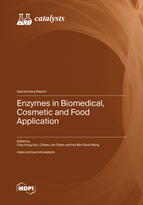Enzymes in Biomedical, Cosmetic and Food Application
A special issue of Catalysts (ISSN 2073-4344). This special issue belongs to the section "Biocatalysis".
Deadline for manuscript submissions: closed (30 September 2023) | Viewed by 31175
Special Issue Editors
Interests: food analysis, food processing, cellulase; lipase esterification and trans esterification; amylase; enzymatic kinetics; ultrasound-assisted enzymatic reaction; enzyme extraction; biotransformation; saccharification; response surface methodology; artificial neural network; wine fermentation
Special Issues, Collections and Topics in MDPI journals
Interests: biodiesel; lipid biocatalysis; enzyme technology; bioprocess optimization; supercritical fluid technology; Chinese herb medicine biotechnology
Special Issues, Collections and Topics in MDPI journals
Interests: tissue engineering; regenerative medicine; drug design; cancer research; food chemistry; dermatology; biochemistry; chemical engineering; proteomics; molecule biology; marine biotechnology & resources
Special Issues, Collections and Topics in MDPI journals
Special Issue Information
Dear Colleagues,
Enzymes are proteins produced by living cells to catalyze reactions, so-called biocatalysts. Enzymes can be produced from animals, plants and microorganisms through extraction and separation. Enzymes have become increasingly popular and are frequently applied in industry because they are highly specific and high catalytic efficiencies. Enzymes offer several advantages in terms of improved reaction selectivity, reduced energy costs, enhanced reliability, environmental friendliness and sustainability. Enzymes are currently widely used in the food industry, pharmaceutical industry, cosmetic industry, and biomedical industry. Many enzymes are used for these applications, such as lipase, protease, amylase, transferases, oxidoreductases, lactase, sucrase, maltase, pectinase, glucosidase, xylanase, cellulase, coenzyme Q10, superoxide dismutase, and peroxidase enzymes. Enzymes are used in the food industry for applications such as starch liquefaction, bread quality improvement, the production of prebiotic food ingredients, flavor improvement, animal feed treatment, and clarification. Enzymes are also used in cosmetics to prevent acne, skin aging, and pigmentation. Increasingly, enzymes are being used in medical applications, including therapeutics, drug delivery, and diagnostics. Therefore, various studies on enzymes have been developed, including those investigating enzyme production, purification, enzyme kinetics, enzyme immobilization, enzyme reactors, biotransformation, the synthesis of bioactive chemical compounds, valuable produce products, as well as enzyme application in analysis, biomedicine and biosensors.
In this Special Issue, we welcome original research articles and reviews focused on all aspects of enzymes used for the food, pharmaceutical, cosmetic, and biomedical industries. Research can be related to biocatalysis, process optimization, ultrasonic processes, food production, fermentation, enzyme-assisted extraction, enzyme production, biocatalytic processes, bio-reactors, food processing, biomass utilization, bioresource application, bio-transformations, enzymology, biological activity, enzymatic synthesis of value-added compounds, nanotechnology, biomedical applications, cosmetic applications, bioremediation and so on.
Prof. Dr. Chia-Hung Kuo
Prof. Dr. Chwen-Jen Shieh
Prof. Dr. Hui-Min David Wang
Guest Editors
Manuscript Submission Information
Manuscripts should be submitted online at www.mdpi.com by registering and logging in to this website. Once you are registered, click here to go to the submission form. Manuscripts can be submitted until the deadline. All submissions that pass pre-check are peer-reviewed. Accepted papers will be published continuously in the journal (as soon as accepted) and will be listed together on the special issue website. Research articles, review articles as well as short communications are invited. For planned papers, a title and short abstract (about 100 words) can be sent to the Editorial Office for announcement on this website.
Submitted manuscripts should not have been published previously, nor be under consideration for publication elsewhere (except conference proceedings papers). All manuscripts are thoroughly refereed through a single-blind peer-review process. A guide for authors and other relevant information for submission of manuscripts is available on the Instructions for Authors page. Catalysts is an international peer-reviewed open access monthly journal published by MDPI.
Please visit the Instructions for Authors page before submitting a manuscript. The Article Processing Charge (APC) for publication in this open access journal is 2700 CHF (Swiss Francs). Submitted papers should be well formatted and use good English. Authors may use MDPI's English editing service prior to publication or during author revisions.
Keywords
- enzyme production
- enzyme purification
- biocatalysis
- optimization
- lipase
- cellulase
- protease
- amylase
- biofuels
- enzymatic-catalyzed synthesis
- enzyme immobilization
- biomass utilization
- environmental protection
- glucosidase
- biotransformation
- enzymatic kinetics
- ultrasound-assisted enzymatic reaction
- bio-reactor
- enzymatic-assisted extraction
- experimental design
- response surface methodology (RSM)
- artificial neural network (ANN)
- drug design
- cancer research
- food chemistry
- dermatology
- biochemistry
- chemical engineering
- proteomics
- molecule biology
- marine biotechnology & resources








